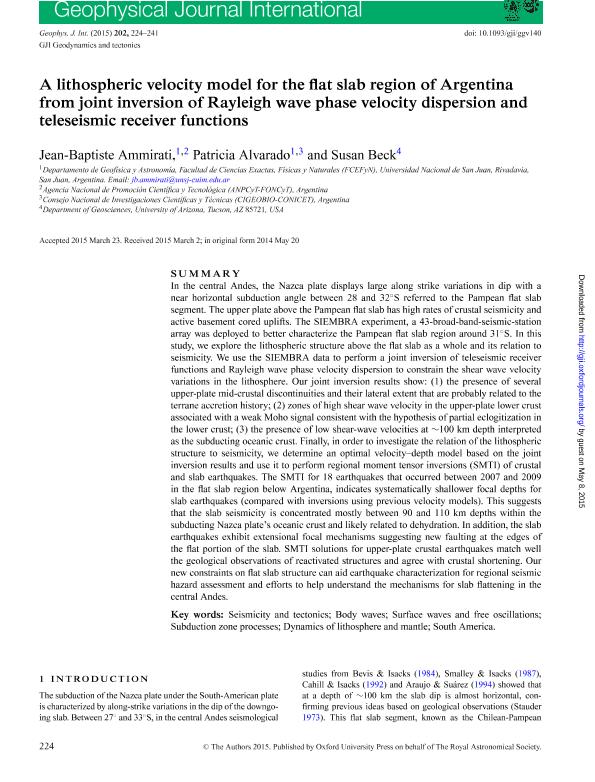Mostrar el registro sencillo del ítem
dc.contributor.author
Ammirati, Jean Baptiste
dc.contributor.author
Alvarado, Patricia Monica

dc.contributor.author
Beck, Susan
dc.date.available
2016-03-18T20:23:17Z
dc.date.issued
2015-03
dc.identifier.citation
Ammirati, Jean Baptiste; Alvarado, Patricia Monica; Beck, Susan; A lithospheric velocity model for the flat slab region of Argentina from joint inversion of Rayleigh wave phase velocity dispersion and teleseismic receiver functions; Wiley; Geophysical Journal International; 202; 3-2015; 224-241
dc.identifier.issn
0956-540X
dc.identifier.uri
http://hdl.handle.net/11336/4871
dc.description.abstract
In the central Andes, the Nazca plate displays large along strike variations in dip with a near horizontal subduction angle between 28 and 32◦S referred to the Pampean flat slab segment. The upper plate above the Pampean flat slab has high rates of crustal seismicity and active basement cored uplifts. The SIEMBRA experiment, a 43-broad-band-seismic-station array was deployed to better characterize the Pampean flat slab region around 31◦S. In this study, we explore the lithospheric structure above the flat slab as a whole and its relation toseismicity. We use the SIEMBRA data to perform a joint inversion of teleseismic receiver functions and Rayleigh wave phase velocity dispersion to constrain the shear wave velocity variations in the lithosphere. Our joint inversion results show: (1) the presence of several upper-plate mid-crustal discontinuities and their lateral extent that are probably related to the terrane accretion history; (2) zones of high shear wave velocity in the upper-plate lower crust associated with a weak Moho signal consistent with the hypothesis of partial eclogitization in the lower crust; (3) the presence of low shear-wave velocities at ∼100 km depth interpreted as the subducting oceanic crust. Finally, in order to investigate the relation of the lithospheric structure to seismicity, we determine an optimal velocity?depth model based on the jointinversion results and use it to perform regional moment tensor inversions (SMTI) of crustal and slab earthquakes. The SMTI for 18 earthquakes that occurred between 2007 and 2009 in the flat slab region below Argentina, indicates systematically shallower focal depths for slab earthquakes (compared with inversions using previous velocity models). This suggests that the slab seismicity is concentrated mostly between 90 and 110 km depths within thesubducting Nazca plate?s oceanic crust and likely related to dehydration. In addition, the slab earthquakes exhibit extensional focal mechanisms suggesting new faulting at the edges of the flat portion of the slab. SMTI solutions for upper-plate crustal earthquakes match well the geological observations of reactivated structures and agree with crustal shortening. Our new constraints on flat slab structure can aid earthquake characterization for regional seismichazard assessment and efforts to help understand the mechanisms for slab flattening in the central Andes.
dc.format
application/pdf
dc.language.iso
eng
dc.publisher
Wiley

dc.rights
info:eu-repo/semantics/openAccess
dc.rights.uri
https://creativecommons.org/licenses/by-nc-sa/2.5/ar/
dc.subject
Seismicity
dc.subject
Tectonics
dc.subject
Body Waves
dc.subject
Surface Waves
dc.subject.classification
Geociencias multidisciplinaria

dc.subject.classification
Ciencias de la Tierra y relacionadas con el Medio Ambiente

dc.subject.classification
CIENCIAS NATURALES Y EXACTAS

dc.title
A lithospheric velocity model for the flat slab region of Argentina from joint inversion of Rayleigh wave phase velocity dispersion and teleseismic receiver functions
dc.type
info:eu-repo/semantics/article
dc.type
info:ar-repo/semantics/artículo
dc.type
info:eu-repo/semantics/publishedVersion
dc.date.updated
2016-03-30 10:35:44.97925-03
dc.journal.volume
202
dc.journal.pagination
224-241
dc.journal.pais
Estados Unidos

dc.journal.ciudad
Hoboken
dc.description.fil
Fil: Ammirati, Jean Baptiste. Ministerio de Ciencia, Tecnología e Innovación Productiva. Agencia Nacional de Promoción Cientifíca y Tecnológica; Argentina. Universidad Nacional de San Juan. Facultad de Ciencias Exactas, Físicas y Naturales. Departamento de Geofísica y Astronomía; Argentina
dc.description.fil
Fil: Alvarado, Patricia Monica. Universidad Nacional de San Juan. Facultad de Ciencias Exactas, Físicas y Naturales. Departamento de Geofísica y Astronomía; Argentina. Consejo Nacional de Investigaciones Científicas y Técnicas. Centro Científico Tecnológico San Juan. Centro de Investigaciones de la Geosfera y Biosfera; Argentina
dc.description.fil
Fil: Beck, Susan. Arizona State University; Estados Unidos
dc.journal.title
Geophysical Journal International

dc.relation.alternativeid
info:eu-repo/semantics/altIdentifier/url/http://gji.oxfordjournals.org/content/202/1/224.abstract
dc.relation.alternativeid
info:eu-repo/semantics/altIdentifier/doi/10.1093/gji/ggv140
dc.relation.alternativeid
info:eu-repo/semantics/altIdentifier/doi/http://dx.doi.org/10.1093/gji/ggv140
Archivos asociados
